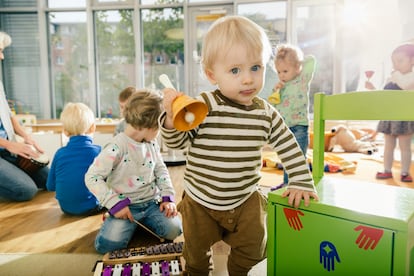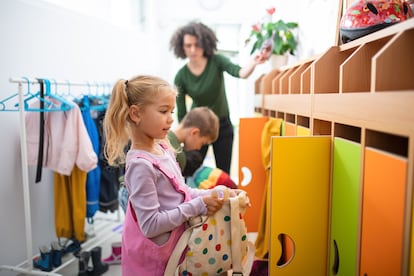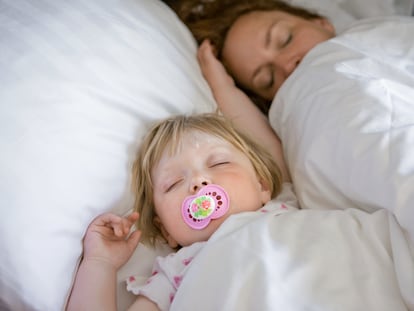What does a child need to be happy from 0 to 3 years old?
The first years of life are key for later development because the brain undergoes unique growth during this period. We offer tips for solving some of parents’ most common concerns during early childhood


Those of us who are nursery school professionals have the good fortune and the great responsibility of supporting our students and their families during their first three years of life. At each stage, different questions emerge, depending on a child’s changes and development. These years are key to a child’s later development because the brain undergoes a unique period of growth during this time. Indeed, thousands of neuronal connections are being formed and strengthened in the first few years. Moreover, this is when the groundwork is laid for everything we can do, learn and be in the future.
Below are the most common questions I have encountered in over 10 years as a professional, as well as keys to optimal childhood development.
From 0 to 1 year old
Numerous researchers consider the first months of a baby’s life to be a critical period, because that is the time when he or she develops a primary attachment, the emotional relationship that the child has with his or her parent or caregiver. The foundations of emotional security are established during this stage. In order to build a secure attachment, it is necessary to respond to their needs, which is why it is so important to hold them when they cry and have physical contact with them, since feeling loved will help them adequately adapt to the world.
When we are not holding our baby in our arms, where can we put him or her? There’s no doubt that the floor is best. The use of bouncers and other restraint systems should be limited. These objects are widely used, but they are the worst enemy of a baby’s motor skill development. Putting them on a firm floor, with attractive objects within their reach, in a comfortable spot that allows them to move freely—without forcing them to hold positions before they have matured enough—is the best option.
Anxiety crises are another issue that often worries parents before their child turns a year old. At around eight months old, a baby starts to cry in the presence of strangers or if their parents disappear from view. This should not be interpreted as a setback but rather as a normal process and an important step toward autonomy. Games like peek-a-boo or the permanence box —Montessori pedagogy’s box with one or more holes or slots to insert objects, with each hole designed so that a certain object fits perfectly—are useful at this point.
From 1 to 2 years old
During this time, spectacular changes occur with advances and progress in the motor, social, cognitive and language skill areas. It is crucial to establish routines, especially sleep and feeding routines, to ensure their rest and well-being. Among many other factors, lack of rest can lead to the first tantrums, as exhaustion leaves them without self-regulation mechanisms. Tantrums are a normal behavior in a child’s development, and between 1 and 2 years of age, children still lack the necessary skills and tools to express their anger or frustration in an acceptable way. Connecting with a calm adult soothes them and helps them identify and regain control over their emotions.
The tantrum period is when the self’s identity is tested, and children begin to try to transgress boundaries. The latter are very important and necessary, as they provide security in the world around them and help them to know themselves and take responsibility. In conclusion, at this stage, children need free space to move around, contact with nature, lots of stories on adults’ laps, connection, limits, puddles to walk in and, above all, play. Play creates powerful learning opportunities in all areas of development.

From 2 to 3 years old
The word “no” begins to gain prominence in the child’s vocabulary, and through their greater mastery of language, children begin to seek independence and self-assertion. During the stage between 2 to 3 years of age, children begin to interact and play with their peers, but they do not always know how to do it in the right way. Biting is often of great concern to families. A child’s mouth is the first thing that establishes contact with the world around him or her. Children explore and interact with their mouths. Biting usually takes place when children still lack sufficient language for expressing their discomfort or frustration; an appropriate response from an adult is important for getting children to stop the tantrum, but the adult must not forget that there’s a need that must be met behind the misbehavior.
Most conflicts at this stage stem from an inability to understand the concept of time when it comes to sharing, so it is advisable not to force them to do so; learning the value of generosity happens over time and should not be forced. At this age, children love to feel capable. It is highly recommended that adults not do anything for toddlers that they can do on their own. They don’t need big things; they need experiences, not screens. They need to learn to take care of an animal, run, jump, play in the park, get dirty in the mud and spend quality time with their family.
We can conclude that, in order to be happy, children need affection, respect, the feeling of capability, connection, active listening, time, play, limits and rules and an education based on values.
Sign up for our weekly newsletter to get more English-language news coverage from EL PAÍS USA Edition
Tu suscripción se está usando en otro dispositivo
¿Quieres añadir otro usuario a tu suscripción?
Si continúas leyendo en este dispositivo, no se podrá leer en el otro.
FlechaTu suscripción se está usando en otro dispositivo y solo puedes acceder a EL PAÍS desde un dispositivo a la vez.
Si quieres compartir tu cuenta, cambia tu suscripción a la modalidad Premium, así podrás añadir otro usuario. Cada uno accederá con su propia cuenta de email, lo que os permitirá personalizar vuestra experiencia en EL PAÍS.
¿Tienes una suscripción de empresa? Accede aquí para contratar más cuentas.
En el caso de no saber quién está usando tu cuenta, te recomendamos cambiar tu contraseña aquí.
Si decides continuar compartiendo tu cuenta, este mensaje se mostrará en tu dispositivo y en el de la otra persona que está usando tu cuenta de forma indefinida, afectando a tu experiencia de lectura. Puedes consultar aquí los términos y condiciones de la suscripción digital.
More information
Últimas noticias
Most viewed
- Reinhard Genzel, Nobel laureate in physics: ‘One-minute videos will never give you the truth’
- Oona Chaplin: ‘I told James Cameron that I was living in a treehouse and starting a permaculture project with a friend’
- Pablo Escobar’s hippos: A serious environmental problem, 40 years on
- Charles Dubouloz, mountaineering star, retires at 36 with a farewell tour inspired by Walter Bonatti
- Why we lost the habit of sleeping in two segments and how that changed our sense of time










































